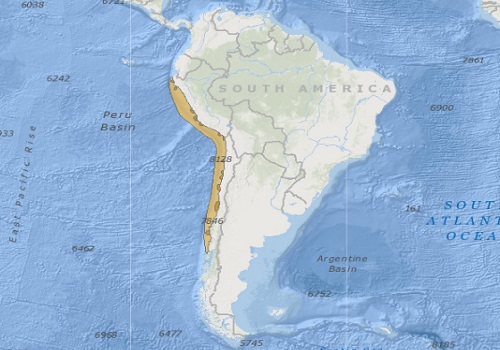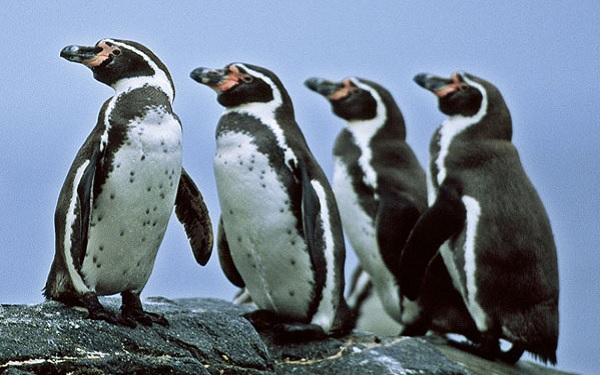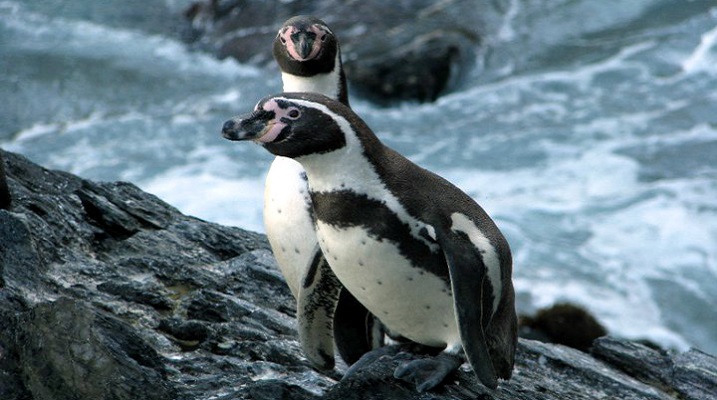Kingdom |
Phylum |
Class |
Order |
Family |
Genus |
Species |
| Animalia | Chordata | Aves | Sphenisciformes | Spheniscidae | Spheniscus |
Speniscus humboldti |
Did you know?
Humboldt penguins are named after the Humboldt current, a nutrient rich current of cold water current that runs along the coast of South America from northern Peru to the south of Chile.
Conservation Status
- The Humboldt penguin is considered Vulnerable by the International Union for the Conservation of Nature (IUCN).
- This species is listed under Appendix I of the Convention on International Trade of Endangered Species of Wild Flora and Fauna (CITES).
- Its population has been greatly affected by El Niño effect . El Niño brings warm water currents collapsing food supply.
- Legislation to protect and assist the recovery of the Humboldt penguin has been passed in both Chile and Peru. In Peru the major colonies are protected and the extraction of guano is managed by the government. In Chile a 30 moratorium on killing or capturing a penguin has been passed, as well as legislation for the protection of the four main breeding colonies.
- Penguins are very sensitive to human contact. Tourism has been limited to a number of islands where penguins breed and guano reserves are being formed to avoid disturbing their habitat.

Distribution and Habitat
- This species occurs in the Pacific coast of South America from Isla Foca in Peru to Isla Guafo in Chile. They are native to Peru and Chile.
- Humboldt penguins spend the majority of their time in coastal waters. The time spent in the water is associated with breeding status. Those breeding spend more time offshore.
- Their preferred breeding sites are rocky islands with large deposits of guano.
- Their home range extends to about 22 miles (35 km) around their breeding site. During El NIño events this range is much larger up to 559 miles (900 km) because of the low availability of food.

Humboldt Penguin distribution map. Map adapted from IUCN.
Population
- This species has undergone extreme fluctuations in population due to El Niño current which brings warm water and prey availability is drastically reduced. During La NIña current food is plentiful guaranteeing chik survival. The higher frequency of El Niño reduces the ability of the population to recover fast enough.
- Its population is estimated at 32,000 mature individuals according to the IUCN.
- Historically the population of Humboldt penguins started its decline in the mid 1800s with guano harvest which removed their nesting habitat.

Humboldt penguins in the south coast of Peru
Physical Features
- The Humboldt penguin is a medium size penguin similar in size to the Magellanic penguin. They have a weight range between 8.8 to 11 lbs (4 to 5 kg) and length between 26 to 28 inches (66 to 70 cm).
- Males are larger than females.
- They have black head bordered by white feathers extending from the eyes around the ears and chin and joining at the throat.
- They have black-gray feathers on the back and white on the chest.
- Their distinctive feature is a solid black upside down horseshoe shaped band across the breast that extends down to the sides of their white belly and down to their feet.
- They have a black bill with a pink colored patch extending to the eyes.
- This bird molts during January and February. Molting is the process of replacing old feathers for new ones. Feathers are very important for penguins as they serve as insulator.
Behavior
- Humboldt penguins are highly social animals and live in large colonies. However, searching for food is a lonely activity. Those who do not have chicks explore further habitats in search of food, those raising chicks take shorter trips.
- Penguins communicate among each other through vocalizations. There are three types: contact, display and threat. They also have an acute sense of smell specially in recognizing their partners and chicks.
- During the two weeks that molting takes place Humboldt penguins do not eat because they cannot enter the water.
- They are very sensitive to human presence, breeding sites are reduced when they are visited by tourists.
Reproduction
- They breed year round with peaks in April-June and August-December.
- Humboldt penguins are monogamous and can recognize their mate by vocal cues and smell.
- They build their nests on the rocky islands along the shore where guano is plentiful. They create burrows and deposit their eggs inside.
- Females lay two eggs per clutch, usually one chick will survive.
- Male and female share the responsibility of attending the nest for a 6 week incubation period.
- When the eggs hatch both parents take turns to feed their chicks.
- Chicks are independent after their first molting at around one year after birth. Less than half make it to the first year.
Diet
- They feed mostly on Peruvian anchovies, Araucanian herring, Common hake, Inca scad, Garfish.
Life Expectancy
- Humboldt penguins in captivity live between 15 to 20 years.
- Life expectancy in the wild is unknown but is less than in captivity due to stress factors.
Predators
- Humboldt penguins have predators both on land and in the sea.
- In the sea are preyed by sea lions, seals and sharks. On land by feral cats, snakes, foxes, dogs and rodents.
Reference and further research
- International Union for the Conservation of Nature – Spheniscus humboldti
- University of Michigan Museum of Zoology – Spheniscus humboldti
- US National Library of Medicine – Vision of the Humboldt penguin (Spheniscus humboldti) in air and water.
- Marine Biology Conservation Society
- World Association of Zoos and Aquariums (WASA) – Humboldt Penguin
- Avibase – the world bird database – Humboldt Penguin Spheniscus humboldti
- Marine Ornithology – Changes in abundance and distribution of Humboldt Penguin Spheniscus humboldti
- US Fish and Wildlife Service Environmental Conservation on line system – Humboldt Penguin
- Google Scholar – Humboldt Penguins
-
El Niño effect and biodiversity on the shores of Peru – The Anchovy case
